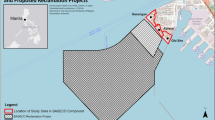Abstract
The coastal area holds great importance as it sustains a large number of people in addition to various bio-networks that have economic as well as biological significance. However, these may be prone to environmental calamities such as tsunamis. In the coastal areas of Pakistan, numerous earthquakes have been triggered by the tectonic movement under the Indian Ocean. Karachi and Gwadar cities being the economic hub of the country is at the potential risk of tsunamis; therefore, multi-criteria GIS mapping of tsunami susceptibility has been conducted in this paper for the Karachi to Gwadar, the coastal area of Pakistan. This study includes many geospatial variables such as coastal proximity and shape, topographic elevation and slope, and topography relative to the direction of the tsunami. Analytic hierarchy process (AHP) is exercised to develop an order of weights for each geospatial variable. For the potential tsunami risk, a land use map of coastal area of Pakistan is overlaid on the tsunami susceptibility map, and the final output map has shown that residential buildings, commercial complexes, and agricultural areas are vulnerable to destruction. Studies involving GIS are helpful in the evaluation of disaster, thereby aiding in the acceleration of local forecasting for the management of natural catastrophes like tsunamis. Tsunami susceptibility map presented in this paper seeks to support the evidence of the occurrence of the tsunami and the efforts directed towards the management of tsunami in the coastal areas of Pakistan.









Similar content being viewed by others
References
Althuwaynee OF, Pradhan B, Park HJ, Lee JH (2014) A novel ensemble bivariate statistical evidential belief function with knowledge-based analytical hierarchy process and multivariate statistical logistic regression for landslide susceptibility mapping. Catena 114:21–36
Aslam B, Muhammad J, Muhammad ZI, Gulraiz A, Quaid IA (2017) GIS Mapping of tsunami susceptibility: case study of the Karachi City in Sindh, Pakistan. J Geogr Nat Disast 7:187. https://doi.org/10.4172/2167-0587.1000187
Bretschneider CL, Wybro PG (1976) Tsunami inundation prediction. Proceedings of the 15th ASCE Conference on Coastal Engineering, pp 1006-1024.
Buchhorn M, Smets B, Bertels L, Lesiv M, Tsendbazar N-E, Herold M, Fritz S (2019) Copernicus Global Land Service: Land Cover 100m, epoch "2015", Globe (Version V2.0.2) [Data set]. Zenodo. https://doi.org/10.5281/zenodo.3243508
Burrough PA, McDonnell RA (1998) Principles of geographical information systems. Oxford University Press, New York, p 356
Cocharda R, Ranamukhaarachchi SL, Shivakoti GP, Shipin OV, Edwards PJ, Seeland KT (2008) The 2004 tsunami in Aceh and Southern Thailand: a review on coastal ecosystems, wave hazards and vulnerability, perspectives in plant ecology. Evol Syst 10(1):3–40
Dall’Osso F, Gonella M, Gabbianelli G, Withycombe G, Dominey-Howes D (2009) A revised (PTVA) model for assessing the vulnerability of buildings to tsunami damage. Nat Hazards Earth Syst Sci 9(5):1557–1565
Diposaptono S, Budiman D (2005) Tsunami: scientific popular book. Bogor, p 125.
Dominey-Howes D, Papathoma M (2007) Validating a tsunami vulnerability assessment model (the PTVA model) using field data from the 2004 Indian Ocean tsunami. Nat Hazards 40(1):113–136. https://doi.org/10.1007/s11069-006-0007-9
Dominey-Howes D, Dunbar P, Varner J, Papathoma-Köhle M (2009) Estimating probable maximum loss from a Cascadia tsunami. Nat Hazards 53(1):43–61
Herath G, Prato T (2006) Using multi-criteria decision analysis in natural resource management. Ashgate Publishing, Surrey, p 239
Irtem E, Gedik N, Kabdasli MS, Yas NE (2009) Coastal forest effects on tsunami run-up heights. Ocean Eng 36(3-4):313–320
Jacob KH, Quittmeyer RC (1978) Makran Region of Pakistan and Iran - Trench-Arc System with Active Plate Subduction. Trans Am Geophys Union 59(4):323–323
Jaffe BE, Gelfenbuam G (2009) A simple model for calculating tsunami flow speed from tsunami deposits. Sediment Geol 200(3-4):347–361
Jenks GF (1963) Generalization in statistical mapping. Ann Assoc Am Geogr 53(1):15–26
Kathiresan K, Rajendran N (2005) Coastal mangrove forests mitigated tsunami. Estuar Coast Shelf Sci 65(3):601–606
Mahboob MA, Atif I, Iqbal J (2015) Remote sensing and GIS applications for assessment of urban sprawl in Karachi, Pakistan. Sci Technol Dev 34:179–188
Murty T, Bapat A (1999) Tsunamis on the coastlines of India. International Tsunami Symposium.
Omira R, Baptista MA, Miranda JM, Toto E, Catita C, Catalão J (2009) Tsunami vulnerability assessment of Casablanca-Morocco using numerical modelling and GIS tools. Nat Hazards 54(1):75–95
Papathoma M, Dominey-Howes D (2003) Tsunami vulnerability assessment and its implications for coastal hazard analysis and disaster management planning, Gulf of Corinth, Greece. Nat Hazards Earth Syst Sci 3(6):733–747
Papathoma M, Dominey-Howes D, Zong Y, Smith D (2003) Assessing tsunami vulnerability, an example from Herakleio, Crete. Nat Hazards Earth Syst Sci 3(5):377–389
Sinaga TPT, Nugroho A, Lee Y et al (2011) GIS mapping of tsunami vulnerability: Case study of the Jembrana regency in Bali, Indonesia. KSCE J Civ Eng 15:537–543. https://doi.org/10.1007/s12205-011-0741-8
Srinivasalu S, Thangadurai N, Switzer AD, Mohan VR, Ayyamperumal T (2007) Erosion and sedimentation in Kalpakkam (N Tamil Nadu, India) from the 26th December 2004 tsunami. Mar Geol 240(1-4):65–75
Wijetunge JJ (2009) Field measurements and numerical simulations of the 2004 tsunami impact on the south coast of Sri Lanka. Ocean Eng 36(12-13):960–973
Yan Z, Tang D (2009) Changes in suspended sediments associated with 2004 Indian Ocean tsunami. Adv Space Res 43(1):89–95
Author information
Authors and Affiliations
Corresponding author
Additional information
Responsible Editor: Amjad Kallel
Rights and permissions
About this article
Cite this article
Aslam, B., Ismail, S. & Maqsoom, A. Geospatial mapping of Tsunami susceptibility of Karachi to Gwadar coastal area of Pakistan. Arab J Geosci 13, 894 (2020). https://doi.org/10.1007/s12517-020-05916-4
Received:
Accepted:
Published:
DOI: https://doi.org/10.1007/s12517-020-05916-4




